SIGNIFICANT POINTS
Nearly two-thirds of the jobs are found in the construction industry; about one quarter are in manufacturing.
Apprenticeship programs lasting 4 or 5 years are considered the best training.
Job opportunities in construction should be good.
NATURE OF THE WORK
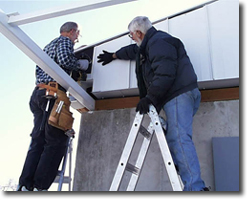 Sheet metal workers make, install, and maintain heating, ventilation, and air-conditioning duct systems; roofs; siding; rain gutters; downspouts; skylights; restaurant equipment; outdoor signs; railroad cars; tailgates; customized precision equipment; and many other products made from metal sheets. They also may work with fiberglass and plastic materials. Although some workers specialize in fabrication, installation, or maintenance, most do all three jobs. Sheet metal workers do both construction-related sheet metal work and mass production of sheet metal products in manufacturing.
Sheet metal workers make, install, and maintain heating, ventilation, and air-conditioning duct systems; roofs; siding; rain gutters; downspouts; skylights; restaurant equipment; outdoor signs; railroad cars; tailgates; customized precision equipment; and many other products made from metal sheets. They also may work with fiberglass and plastic materials. Although some workers specialize in fabrication, installation, or maintenance, most do all three jobs. Sheet metal workers do both construction-related sheet metal work and mass production of sheet metal products in manufacturing.
Sheet metal workers first study plans and specifications to determine the kind and quantity of materials they will need. They then measure, cut, bend, shape, and fasten pieces of sheet metal to make ductwork, countertops, and other custom products. In an increasing number of shops, sheet metal workers use computerized metalworking equipment. This enables them to perform their tasks more quickly and to experiment with different layouts to find the one that results in the least waste of material. They cut, drill, and form parts with computer-controlled saws, lasers, shears, and presses.
In shops without computerized equipment, and for products that cannot be made on such equipment, sheet metal workers use hand calculators to make the required calculations and use tapes, rulers, and other measuring devices for layout work. They then cut or stamp the parts on machine tools.
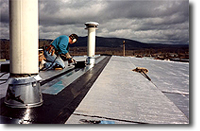 Before assembling pieces, sheet metal workers check each part for accuracy using measuring instruments such as calipers and micrometers and, if necessary, finish it by using hand, rotary, or squaring shears and hacksaws. After the parts have been inspected, workers fasten seams and joints together with welds, bolts, cement, rivets, solder, specially formed sheet metal drive clips, or other connecting devices. They then take the parts to the construction site, where they further assemble the pieces as they install them. These workers install ducts, pipes, and tubes by joining them end to end and hanging them with metal hangers secured to a ceiling or a wall. They also use shears, hammers, punches, and drills to make parts at the worksite or to alter parts made in the shop.
Before assembling pieces, sheet metal workers check each part for accuracy using measuring instruments such as calipers and micrometers and, if necessary, finish it by using hand, rotary, or squaring shears and hacksaws. After the parts have been inspected, workers fasten seams and joints together with welds, bolts, cement, rivets, solder, specially formed sheet metal drive clips, or other connecting devices. They then take the parts to the construction site, where they further assemble the pieces as they install them. These workers install ducts, pipes, and tubes by joining them end to end and hanging them with metal hangers secured to a ceiling or a wall. They also use shears, hammers, punches, and drills to make parts at the worksite or to alter parts made in the shop.
Some jobs are done completely at the jobsite. When installing a metal roof, for example, sheet metal workers measure and cut the roofing panels that are needed to complete the job. They secure the first panel in place and interlock and fasten the grooved edge of the next panel into the grooved edge of the first. Then, they nail or weld the free edge of the panel to the structure. This two-step process is repeated for each additional panel. Finally, the workers fasten machine-made molding at joints, along corners, and around windows and doors for a neat, finished effect.
In addition to installation, some sheet metal workers specialize in testing, balancing, adjusting, and servicing existing air-conditioning and ventilation systems to make sure they are functioning properly and to improve their energy efficiency. Properly installed duct systems are a key component to heating, ventilation, and air-conditioning (HVAC) systems, which causes duct installers to sometimes be referred to as HVAC technicians. A duct system allows for even air distribution while minimizing leaks and temperature differentiation that can cause other problems, such as mold.
Sheet metal workers in manufacturing plants make sheet metal parts for products such as aircraft or industrial equipment. Although some of the fabrication techniques used in large-scale manufacturing are similar to those used in smaller shops, the work may be highly automated and repetitive. Sheet metal workers doing such work may be responsible for reprogramming the computer control systems of the equipment they operate.
WORKING CONDITIONS
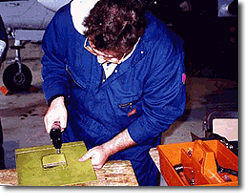 Sheet metal workers usually work a 40-hour week. Those who fabricate sheet metal products work in shops that are well-lighted and well-ventilated. However, they stand for long periods and lift heavy materials and finished pieces. Sheet metal workers must follow safety practices because working around high-speed machines can be dangerous. They also are subject to cuts from sharp metal, burns from soldering and welding, and falls from ladders and scaffolds. They usually wear safety glasses but must not wear jewelry or loose-fitting clothing that could easily be caught in a machine. They may work at a variety of different production stations to reduce the repetitiveness of the work.
Sheet metal workers usually work a 40-hour week. Those who fabricate sheet metal products work in shops that are well-lighted and well-ventilated. However, they stand for long periods and lift heavy materials and finished pieces. Sheet metal workers must follow safety practices because working around high-speed machines can be dangerous. They also are subject to cuts from sharp metal, burns from soldering and welding, and falls from ladders and scaffolds. They usually wear safety glasses but must not wear jewelry or loose-fitting clothing that could easily be caught in a machine. They may work at a variety of different production stations to reduce the repetitiveness of the work.
Those performing installation work do considerable bending, lifting, standing, climbing, and squatting, sometimes in close quarters or in awkward positions. Although duct systems and kitchen equipment are installed indoors, the installation of siding, roofs, and gutters involves much outdoor work, requiring sheet metal workers to be exposed to various kinds of weather.
EMPLOYMENT
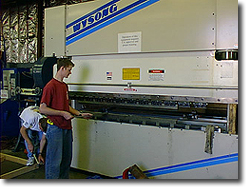 Sheet metal workers held about 205,000 jobs in 2002. Nearly two-thirds of all sheet metal workers were found in the construction industry. Of those employed in construction, almost half worked for plumbing, heating, and air-conditioning contractors; most of the rest worked for roofing and sheet metal contractors. Some worked for other special trade contractors and for general contractors engaged in residential and commercial building. One-quarter of all sheet metal workers work outside of construction and are found in manufacturing industries, such as the fabricated metal products, machinery, and aerospace products and parts industries. Some work for the Federal Government.
Sheet metal workers held about 205,000 jobs in 2002. Nearly two-thirds of all sheet metal workers were found in the construction industry. Of those employed in construction, almost half worked for plumbing, heating, and air-conditioning contractors; most of the rest worked for roofing and sheet metal contractors. Some worked for other special trade contractors and for general contractors engaged in residential and commercial building. One-quarter of all sheet metal workers work outside of construction and are found in manufacturing industries, such as the fabricated metal products, machinery, and aerospace products and parts industries. Some work for the Federal Government.
Compared with workers in most construction craft occupations, relatively few sheet metal workers are self-employed.
TRAINING, OTHER QUALIFICATIONS, AND ADVANCEMENT
Apprenticeship generally is considered to be the best way to learn this trade. The apprenticeship program consists of 4 or 5 years of on-the-job training and an average of 200 hours per year of classroom instruction. Apprenticeship programs provide comprehensive instruction in both sheet metal fabrication and installation. They may be administered by local joint committees composed of the Sheet Metal Workers' International Association and local chapters of the Sheet Metal and Air-Conditioning Contractors National Association.
On the job, apprentices learn the basics of pattern layout and how to cut, bend, fabricate, and install sheet metal. They begin by learning to install and maintain basic ductwork and gradually advance to more difficult jobs, such as making more complex ducts, commercial kitchens, and decorative pieces. They also use materials such as fiberglass, plastics, and other nonmetallic materials. Some workers may focus on exterior or architectural sheet metal installation.
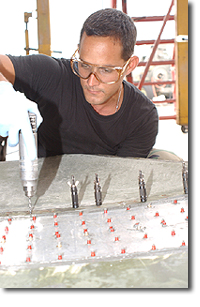 In the classroom, apprentices learn drafting, plan and specification reading, trigonometry and geometry applicable to layout work, the use of computerized equipment, welding, and the principles of heating, air-conditioning, and ventilating systems. Safety is stressed throughout the program. In addition, apprentices learn the relationship between sheet metal work and other construction work.
In the classroom, apprentices learn drafting, plan and specification reading, trigonometry and geometry applicable to layout work, the use of computerized equipment, welding, and the principles of heating, air-conditioning, and ventilating systems. Safety is stressed throughout the program. In addition, apprentices learn the relationship between sheet metal work and other construction work.
Some persons pick up the trade informally, usually by working as helpers to experienced sheet metal workers. Most begin by carrying metal and cleaning up debris in a metal shop while they learn about materials and tools and their uses. Later, they learn to operate machines that bend or cut metal. In time, helpers go out on the jobsite to learn installation. Those who acquire their skills this way often take vocational school courses in mathematics or sheet metal fabrication to supplement their work experience. To be promoted to the journey level, helpers usually must pass the same written examination as apprentices. Most sheet metal workers in large-scale manufacturing receive on-the-job training, with additional classwork or in-house training when necessary.
Applicants for jobs as apprentices or helpers should be in good physical condition and have mechanical and mathematical aptitude as well as good reading skills. Good eye-hand coordination, spatial and form perception, and manual dexterity also are important. Local apprenticeship committees require a high school education or its equivalent. Courses in algebra, trigonometry, geometry, mechanical drawing, and shop provide a helpful background for learning the trade, as does related work experience obtained in the Armed Services.
It is important for experienced sheet metal workers to keep abreast of new technological developments, such as the growing use of computerized layout and laser-cutting machines. Workers often take additional training, provided by the union or by their employer, to improve existing skills or to acquire new ones.
Sheet metal workers in construction may advance to supervisory jobs. Some of these workers take additional training in welding and do more specialized work. Others go into the contracting business for themselves. Because a sheet metal contractor must have a shop with equipment to fabricate products, this type of contracting business is more expensive to start than other types of construction contracting. Sheet metal workers in manufacturing may advance to positions as supervisors or quality inspectors. Some of these workers may move into other management positions.
JOB OUTLOOK
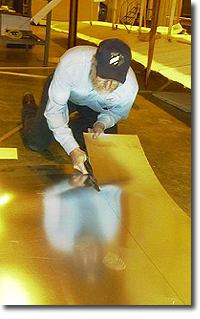 Job opportunities are expected to be good for sheet metal workers in the construction industry and in construction-related sheet metal fabrication, reflecting both employment growth and openings arising each year as experienced sheet metal workers leave the occupation. In addition, many potential workers may prefer work that is less strenuous and that has more comfortable working conditions, thus limiting the number of applicants for sheet metal jobs. Opportunities should be particularly good for individuals who acquire apprenticeship training. Job prospects in manufacturing will not be as good because construction is expected to grow faster than the manufacturing industries that employ sheet metal workers. Because some sheet metal manufacturing is labor-intensive, manufacturers sometimes move production to lower wage areas or countries.
Job opportunities are expected to be good for sheet metal workers in the construction industry and in construction-related sheet metal fabrication, reflecting both employment growth and openings arising each year as experienced sheet metal workers leave the occupation. In addition, many potential workers may prefer work that is less strenuous and that has more comfortable working conditions, thus limiting the number of applicants for sheet metal jobs. Opportunities should be particularly good for individuals who acquire apprenticeship training. Job prospects in manufacturing will not be as good because construction is expected to grow faster than the manufacturing industries that employ sheet metal workers. Because some sheet metal manufacturing is labor-intensive, manufacturers sometimes move production to lower wage areas or countries.
Employment of sheet metal workers in construction is expected to grow about as fast as the average for all occupations through 2012, reflecting growth in the demand for sheet metal installations as more industrial, commercial, and residential structures are built. The need to install energy-efficient air-conditioning, heating, and ventilation systems in the increasing stock of old buildings and to perform other types of renovation and maintenance work also should boost employment. In addition, the popularity of decorative sheet metal products and increased architectural restoration are expected to add to the demand for sheet metal workers. On the other hand, slower-than-average job growth is projected for sheet metal workers in manufacturing.
Sheet metal workers in construction may experience periods of unemployment, particularly when construction projects end and economic conditions dampen construction activity. Nevertheless, employment of sheet metal workers is less sensitive to declines in new construction than is the employment of some other construction workers, such as carpenters. Maintenance of existing equipment-which is less affected by economic fluctuations than is new construction-makes up a large part of the work done by sheet metal workers. Installation of new air-conditioning and heating systems in existing buildings continues during construction slumps, as individuals and businesses adopt more energy-efficient equipment to cut utility bills. In addition, a large proportion of sheet metal installation and maintenance is done indoors, so sheet metal workers usually lose less worktime due to bad weather than other construction workers do.
EARNINGS
In 2002, median hourly earnings of sheet metal workers were $16.62. The middle 50 percent earned between $12.15 and $23.03. The lowest 10 percent of all sheet metal workers earned less than $9.50, and the highest 10 percent earned more than $29.53. The median hourly earnings of the largest industries employing sheet metal workers in 2002 are shown below.
| Federal Government |
$19.73 |
| Building equipment contractors |
$17.47 |
| Building finishing contractors |
$16.77 |
| Foundation, structure, and building exterior contractors |
$15.48 |
| Architectural and structural metals manufacturing |
$14.60 |
Apprentices normally start at about 40 to 50 percent of the rate paid to experienced workers. As apprentices acquire more skills throughout the course of their training, they receive periodic increases until their pay approaches that of experienced workers. In addition, union workers in some areas receive supplemental wages from the union when they are on layoff or shortened workweeks.
RELATED OCCUPATIONS
To fabricate and install sheet metal products, sheet metal workers combine metalworking skills and knowledge of construction materials and techniques. Other occupations in which workers lay out and fabricate metal products include assemblers and fabricators; machinists; machine setters, operators, and tenders-metal and plastic; and tool and die makers. Construction occupations requiring similar skills and knowledge include glaziers and heating, air-conditioning, and refrigeration mechanics and installers.
SOURCES OF ADDITIONAL INFORMATION
For more information about apprenticeships or other work opportunities, contact local sheet metal contractors or heating, refrigeration, and air-conditioning contractors; a local of the Sheet Metal Workers International Association; a local of the Sheet Metal and Air-Conditioning Contractors National Association; a local joint union-management apprenticeship committee; or the nearest office of your State employment service or apprenticeship agency.
For general and training information about sheet metal workers, contact:
- International Training Institute for the Sheet Metal and Air-Conditioning Industry, 601 N. Fairfax St., Suite 240, Alexandria, VA 22314. Internet: http://www.sheetmetal-iti.org
- Sheet Metal and Air-Conditioning Contractors National Association, 4201 Lafayette Center Dr., Chantilly, VA 20151-1209. Internet: http://www.smacna.org
There are more than 500 occupations registered by the U.S. Department of Labor's National Apprenticeship system. For more information on the Labor Department's registered apprenticeship system and links to State apprenticeship programs, check their Web site: http://www.doleta.gov
|